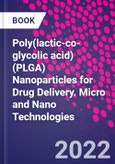Poly(lactic-co-glycolic acid) (PLGA) Nanoparticles for Drug Delivery is a comprehensive guide to PLGA nanoparticles for targeting various diseases, covering principles, formation, characterization, applications, regulations and the latest advances. Sections introduce the fundamental aspects of PLGA nanoparticles for drug delivery, including properties, preparation methods, characterization, drug loading methods, and drug release mechanisms, along with a focus on applications. Application of PLGA nanoparticles for the treatment of cancer, inflammatory, cerebral, cardiovascular, and infectious diseases, as well as in regenerative medicine, photodynamic and photothermal therapy, and gene therapy, are all explained in detail.
The final chapters explore recent advances and regulatory aspects. This book is a valuable resource for researchers and advanced students across nanomedicine, polymer science, bio-based materials, chemistry, biomedicine, biotechnology, and materials engineering, as well as for industrial scientists and R&D professionals with an interest in nanoparticles for drug delivery, pharmaceutical formulations and regulations, and development of innovative biodegradable materials.
Please Note: This is an On Demand product, delivery may take up to 11 working days after payment has been received.
Table of Contents
PART A Synthesis and characterization of PLGA nanoparticles for drug delivery 1. History, introduction, and properties of PLGA nanoparticles as drug delivery carriers 2. Preparation and characterization of PLGA nanoparticles 3. Drug loading methods and mechanism of drug release from PLGA nanoparticles 4. Biofate and cellular interactions of PLGA nanoparticles
PART B Application of PLGA nanoparticles in drug delivery 5. Targeting strategies using PLGA nanoparticles for efficient drug delivery 6. Current progress in PLGA-based nanoparticles for treatment of cancer diseases 7. PLGA-based nanoparticles for enhanced diagnosis and cancer therapy 8. PLGA-based nanoparticles for the treatment of inflammatory diseases 9. PLGA-based nanoparticles for treatment of cerebral diseases 10. PLGA-based nanoparticles for treatment of cardiovascular diseases 11. PLGA-based nanoparticles for treatment of infectious diseases 12. PLGA-based nanoparticles as regenerative medicine 13. Photodynamic and photothermal therapy using PLGA nanoparticles 14. Gene therapy using PLGA nanoparticles
PART C Recent advances and regulatory aspects in PLGA nanoparticles 15. Hybrid PLGA nanoparticles as advanced drug delivery and theranostic applications 16. Clinical translation of PLGA nanoparticles into the market 17. Biological toxicity and environmental hazards associated with PLGA nanoparticles 18. PLGA nanoparticles: Current uses and emerging trends
Authors
Prashant Kesharwani Assistant Professor, Department of Pharmaceutics, School of Pharmaceutical Education and Research, Jamia Hamdard, New Delhi, India.Dr. Prashant Kesharwani is working as an assistant professor of pharmaceutics at the School of Pharmaceutical Education and Research, Jamia Hamdard University, New Delhi, India. He has more than 12 years of teaching, research, and industrial experience at international levels from various countries, including the United States, Malaysia, and India. An overarching goal of his current research is the development of nanoengineered drug delivery systems for various diseases. He has more than 300 international publications in well-reputed journals and more than 20 international books (Elsevier). He is a recipient of many research grants from various funding bodies. He is also a receipt of several internationally acclaimed awards such as the most prestigious "Ramanujan Fellowship Award� from the Science and Engineering Research Board, Government of India. He actively participates in outreach and scientific dissemination for the service of the wider community.








